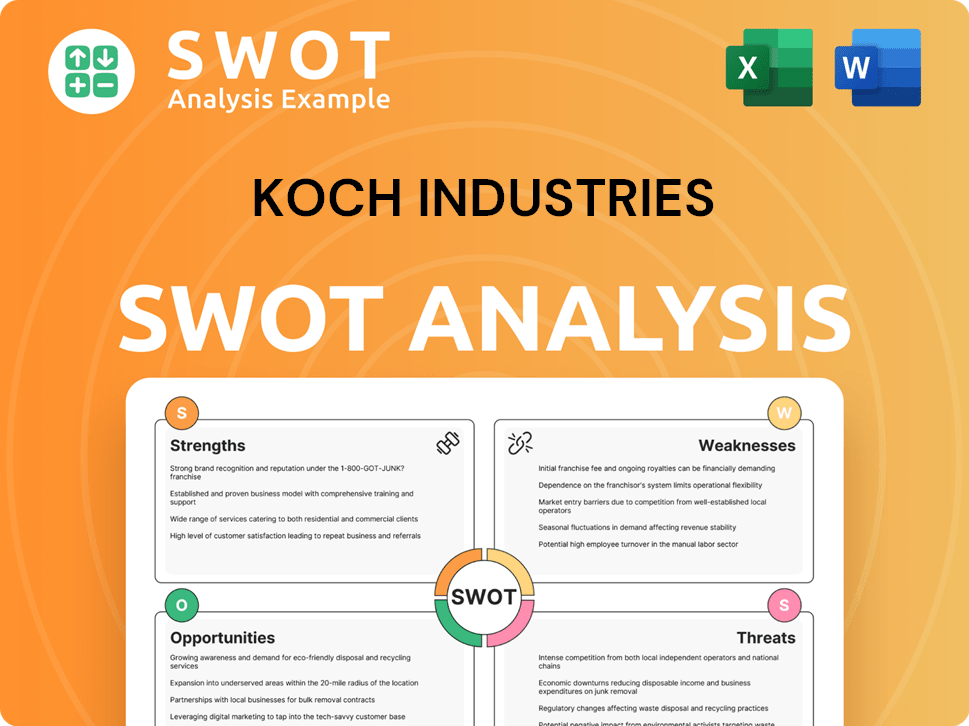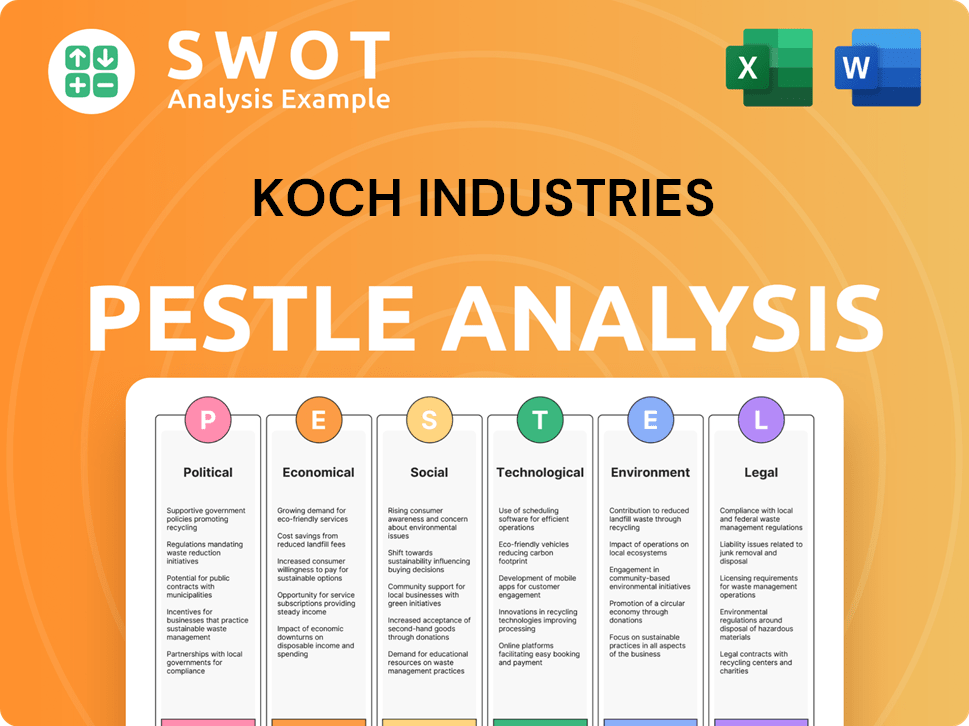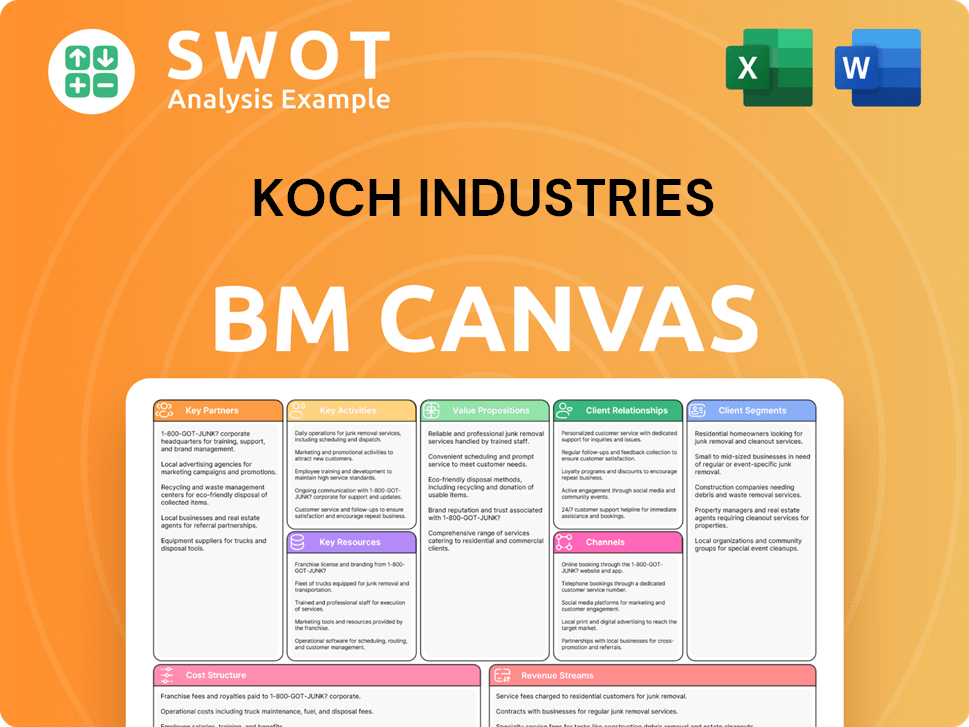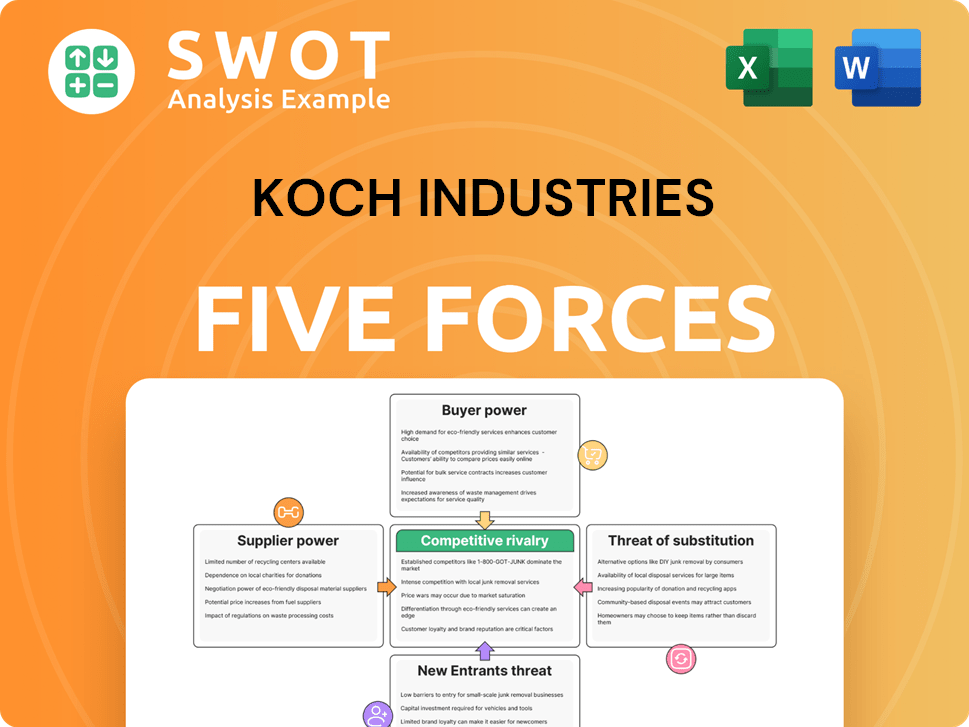Koch Industries Bundle
How Does Koch Industries Thrive?
Koch Industries, a privately held giant, casts a long shadow across the global industrial stage. With an estimated $125 billion in revenue in 2023, this behemoth operates in sectors vital to our daily lives, from energy to consumer goods. Its vast and varied operations make understanding the Koch Industries SWOT Analysis and its inner workings crucial for anyone seeking to understand the modern business landscape.

This exploration into the Koch business model will dissect how Koch Industries, under the leadership of Charles Koch, creates value and maintains its competitive edge. We'll delve into the Koch Industries structure, its extensive network of Koch Industries subsidiaries, and the strategic philosophies that drive its success. Whether you're curious about Koch Industries ownership structure, its impact on various industries, or how this company navigates complex challenges, this analysis offers invaluable insights.
What Are the Key Operations Driving Koch Industries’s Success?
Koch Industries operates across diverse sectors, generating value through efficiency, innovation, and sustainability. The company's core offerings include refined petroleum products, chemicals, fertilizers, polymers, and various software solutions. These products and services cater to a wide range of customers, from industrial clients to individual consumers worldwide.
The operational framework at Koch Industries emphasizes vertical integration, advanced manufacturing, and sophisticated supply chain management. Subsidiaries like Flint Hills Resources and INVISTA are key players in transforming raw materials into valuable products. Georgia-Pacific manages extensive forest resources and manufactures building materials, showcasing a comprehensive approach.
A distinctive feature of Koch Industries is its Market-Based Management (MBM) framework. This framework empowers employees to act as entrepreneurs, fostering continuous improvement and value creation across business units. This decentralized yet interconnected model enables the company to adapt swiftly to market changes, providing high-quality, cost-effective products and reliable supply chains.
Koch Industries operates through several key business segments. These include refining, chemicals, and building materials. Other segments focus on fertilizers, polymers, and electronic components. Each segment contributes to the overall revenue and strategic goals of the company.
The value proposition of Koch Industries centers on delivering high-quality, cost-effective products and services. This is achieved through operational excellence, innovation, and a focus on customer needs. The company's diversified portfolio allows it to serve various markets and adapt to changing economic conditions.
Koch Industries emphasizes operational excellence through vertical integration and advanced manufacturing. They utilize sophisticated supply chain management to ensure efficient delivery of products. This approach allows the company to maintain competitive advantages and meet customer demands effectively.
The Market-Based Management (MBM) framework is a key differentiator for Koch Industries. It empowers employees to act as entrepreneurs, fostering a culture of continuous improvement. This decentralized model allows the company to adapt quickly to market changes and capitalize on new opportunities.
Several subsidiaries significantly contribute to Koch Industries' operations. Flint Hills Resources focuses on refining and chemicals, while INVISTA produces specialty chemicals and polymers. Georgia-Pacific manages forest resources and manufactures building materials, demonstrating a comprehensive approach.
- Flint Hills Resources: Refining and chemicals.
- INVISTA: Specialty chemicals, polymers, and fibers.
- Georgia-Pacific: Pulp, paper, and building materials.
- Other: Electronic components and software solutions.
Koch Industries SWOT Analysis
- Complete SWOT Breakdown
- Fully Customizable
- Editable in Excel & Word
- Professional Formatting
- Investor-Ready Format

How Does Koch Industries Make Money?
The revenue streams and monetization strategies of Koch Industries are diverse, reflecting its vast industrial operations. As a privately held company, detailed financial breakdowns are not publicly available. However, its primary revenue sources come from selling a wide array of products across various sectors.
These sectors include refined petroleum products, chemicals, polymers, fertilizers, pulp and paper, building materials, and consumer goods. Koch Industries employs distinct monetization strategies within each subsidiary, optimizing production costs and maximizing market share.
The company’s long-term investment approach supports strategies that may not yield immediate returns but build sustainable value, such as investing in new technologies and expanding into emerging markets. For more insights, explore the Growth Strategy of Koch Industries.
Koch Industries generates revenue primarily through the direct sale of manufactured goods, focusing on optimizing production costs and maximizing market share. Subsidiaries like Flint Hills Resources sell refined fuels and chemicals, while Georgia-Pacific focuses on direct sales to businesses and consumers. INVISTA sells specialty chemicals and fibers, and Koch Ag & Energy Solutions sells fertilizers. The company also utilizes licensing agreements and offers services like software and data analytics.
- Flint Hills Resources: Refined fuels and chemicals.
- Georgia-Pacific: Building materials, paper products.
- INVISTA: Specialty chemicals and fibers.
- Koch Ag & Energy Solutions: Fertilizers and agricultural products.
Koch Industries PESTLE Analysis
- Covers All 6 PESTLE Categories
- No Research Needed – Save Hours of Work
- Built by Experts, Trusted by Consultants
- Instant Download, Ready to Use
- 100% Editable, Fully Customizable

Which Strategic Decisions Have Shaped Koch Industries’s Business Model?
Koch Industries' journey is marked by significant milestones and strategic moves that have shaped its operations and financial performance. A pivotal aspect of its growth has been a series of strategic acquisitions, which have dramatically expanded its reach and diversified its portfolio. These moves exemplify Koch's strategy of acquiring established businesses and integrating them into its MBM framework to unlock further value through operational efficiencies and synergistic opportunities.
The company has consistently faced operational and market challenges, including fluctuating commodity prices, stringent environmental regulations, and global economic downturns. Koch's response has often involved significant investments in process optimization, technological advancements, and diversification to mitigate risks. For instance, its continued investment in sustainable practices and renewable energy projects within its various subsidiaries demonstrates an adaptation to evolving environmental concerns and regulatory landscapes. The company continues to adapt to new trends by investing in areas like digital transformation, advanced manufacturing, and sustainable technologies, ensuring its continued relevance and competitive edge in a dynamic global economy.
Koch Industries' competitive advantages are multifaceted: its sheer economies of scale across diverse industries, its proprietary MBM philosophy which fosters innovation and efficiency, strong brand recognition within its various sectors, and a relentless focus on long-term value creation rather than short-term gains. Understanding the Brief History of Koch Industries can provide further context on its evolution and strategic decisions.
Koch Industries has made several key acquisitions to expand its business. Notable acquisitions include Georgia-Pacific in 2005 for $21 billion, and INVISTA (formerly DuPont Textiles & Interiors) in 2004. These acquisitions have significantly broadened Koch's presence in various sectors, including pulp, paper, building products, polymers, and fibers.
The company consistently invests in process optimization and technological advancements. Koch has also increased its investments in sustainable practices and renewable energy projects. These investments reflect Koch's adaptation to changing market conditions and environmental concerns.
Koch Industries benefits from economies of scale across diverse industries. The company utilizes its proprietary MBM philosophy to drive innovation and efficiency. Strong brand recognition within its various sectors and a focus on long-term value creation are also key advantages.
Koch continues to adapt to new trends by investing in areas like digital transformation, advanced manufacturing, and sustainable technologies. These investments help ensure its continued relevance and competitive edge in a dynamic global economy. The company is focused on areas that will drive future growth.
Koch Industries is a privately held company, and its financial details are not publicly disclosed. However, it is known for its substantial revenue and diverse portfolio of businesses. The company's strategic moves and investments have positioned it as a major player in several sectors, including manufacturing, energy, and chemicals.
- Koch Industries' revenue is estimated to be in the hundreds of billions of dollars annually.
- The company's diverse business segments contribute to its overall financial stability.
- Strategic acquisitions and investments have fueled its growth and market position.
- Koch Industries' focus on long-term value creation supports its sustained financial performance.
Koch Industries Business Model Canvas
- Complete 9-Block Business Model Canvas
- Effortlessly Communicate Your Business Strategy
- Investor-Ready BMC Format
- 100% Editable and Customizable
- Clear and Structured Layout

How Is Koch Industries Positioning Itself for Continued Success?
Koch Industries holds a prominent position across various sectors, often ranking among the top competitors in its industries. Subsidiaries like Flint Hills Resources are key players in refining and chemicals in North America. Georgia-Pacific is a global leader in tissue, pulp, paper, and building products, while INVISTA maintains a strong presence in fibers and polymers. This scale, integrated supply chains, and technological prowess contribute to substantial market share and customer loyalty.
However, Koch Industries faces several significant risks. These include fluctuations in commodity prices, impacting energy and chemical business profitability. Regulatory changes, particularly in environmental and energy policies, pose ongoing challenges. Global economic downturns and geopolitical instability can also affect demand for its industrial products. The shift towards sustainability and a lower-carbon economy presents both risks and opportunities, requiring continuous innovation and investment in green technologies.
Koch Industries is a privately held company with a diverse portfolio. It operates in several sectors, including refining, chemicals, forest products, and investments. The company's structure allows for flexibility and strategic decision-making across its various businesses.
The company faces risks related to market volatility, regulatory changes, and geopolitical instability. Environmental concerns and the transition to a lower-carbon economy also present challenges. These factors can impact profitability and require strategic adaptation.
Koch Industries focuses on innovation, strategic investments, and operational optimization. The company emphasizes long-term value creation and a culture of entrepreneurship. It is expected to pursue strategic acquisitions and partnerships.
The company's diverse business segments and operational excellence enable it to sustain and expand profitability. Its ability to navigate global economic and regulatory landscapes is key. For more details, see Marketing Strategy of Koch Industries.
Koch Industries' strategies include innovation, strategic investments, and operational excellence. The company focuses on market-based management and a culture of entrepreneurship. These elements are essential for long-term value creation and adaptability.
- Innovation in technologies and processes.
- Strategic acquisitions and partnerships.
- Optimization of existing operations.
- Adaptation to changing market conditions.
Koch Industries Porter's Five Forces Analysis
- Covers All 5 Competitive Forces in Detail
- Structured for Consultants, Students, and Founders
- 100% Editable in Microsoft Word & Excel
- Instant Digital Download – Use Immediately
- Compatible with Mac & PC – Fully Unlocked

Related Blogs
- What are Mission Vision & Core Values of Koch Industries Company?
- What is Competitive Landscape of Koch Industries Company?
- What is Growth Strategy and Future Prospects of Koch Industries Company?
- What is Sales and Marketing Strategy of Koch Industries Company?
- What is Brief History of Koch Industries Company?
- Who Owns Koch Industries Company?
- What is Customer Demographics and Target Market of Koch Industries Company?
Disclaimer
All information, articles, and product details provided on this website are for general informational and educational purposes only. We do not claim any ownership over, nor do we intend to infringe upon, any trademarks, copyrights, logos, brand names, or other intellectual property mentioned or depicted on this site. Such intellectual property remains the property of its respective owners, and any references here are made solely for identification or informational purposes, without implying any affiliation, endorsement, or partnership.
We make no representations or warranties, express or implied, regarding the accuracy, completeness, or suitability of any content or products presented. Nothing on this website should be construed as legal, tax, investment, financial, medical, or other professional advice. In addition, no part of this site—including articles or product references—constitutes a solicitation, recommendation, endorsement, advertisement, or offer to buy or sell any securities, franchises, or other financial instruments, particularly in jurisdictions where such activity would be unlawful.
All content is of a general nature and may not address the specific circumstances of any individual or entity. It is not a substitute for professional advice or services. Any actions you take based on the information provided here are strictly at your own risk. You accept full responsibility for any decisions or outcomes arising from your use of this website and agree to release us from any liability in connection with your use of, or reliance upon, the content or products found herein.